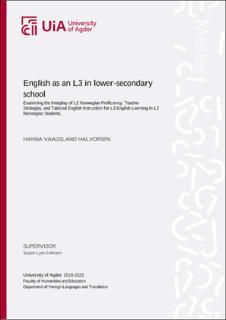| dc.description.abstract | This thesis examines the L2 proficiency impact on L3 learners in lower secondary schools in Norway. The project will examine different aspects of teaching and learning a third language, how the school system handles linguistic transfer, and how multilingualism is discussed in class. This study is a continuation of the previous studies on multilingualism and focuses on the importance of adapted teaching strategies. The study aims to offer insight into how students and teachers experience and handle the situation with increasingly linguistic and cultural classrooms. The study examined four teachers and eleven students and consisted of interviews, observation, and document examination.
The thesis attempts to use these three investigatory methods to understand how L2 impacts L3 learning, as well as how transfer and metacognitive strategies are used in the classroom. The thesis also attempts to figure out how English instruction can best be tailored to meet the needs of 2 Norwegian students. Being fluent in English is a vital and helpful instrument for education and socialization in the globalized world of interrelated commerce, higher education, personal mobility, and social media. However, the emphasis on English proficiency creates a significant competency gap between children who have been studying the language since the age of six and those who have recently relocated to Norway and have yet to gain prior exposure to either Norwegian or English. While this study offers no comprehensive investigation into L2 proficiency's impact on L3 learning, it does attempt to offer some insight into students' and teachers' experiences in the English classroom.
This study found that the students present a significant change in confidence when faced with oral communication tasks, as opposed to written tasks. The students excelled in communication, supporting the theories of Communicative Language Learning (CLT) as a helpful tool, as well as being the centre of attention, when fostering language abilities in the educational settings of the Western world (Fenner & Skulstad, 2018).
Further, teachers expressed a need for more knowledge, resources, and time to actively adapt and gain the competence needed for specialised and targeted help and feedback.
Regarding L2 proficiency's impact on L3, students presented transfer and mirroring from their L2 when producing texts in their L3. It was also recorded that students' L1 impacted their L3 when writing, as students felt overwhelmed and resorted to their L1 as support.
This study contributes to the research on multilingualism and linguistic transfer in Norwegian lower secondary schools.
Further, it provides teachers, and potentially students, with helpful insights into the importance of linguistic and cultural awareness and an interest in the student's diverse linguistic backgrounds.
Key words: foreign language acquisition, multilingualism, linguistic transfer, adapted learning, AcEngMulCla, intercultural communication. | |
